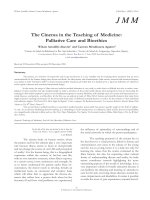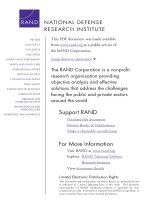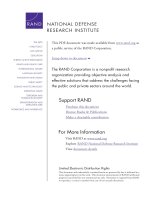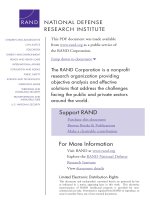Civilian Workforce Planning in the Department of Defense - Different Levels, Different Roles pptx
Bạn đang xem bản rút gọn của tài liệu. Xem và tải ngay bản đầy đủ của tài liệu tại đây (437.77 KB, 152 trang )
This document and trademark(s) contained herein are protected by law
as indicated in a notice appearing later in this work. This electronic
representation of RAND intellectual property is provided for non-
commercial use only. Permission is required from RAND to reproduce, or
reuse in another form, any of our research documents.
Limited Electronic Distribution Rights
Visit RAND at www.rand.org
Explore RAND National Defense
Research Institute
View document details
For More Information
This PDF document was made available
from www.rand.org as a public service of
the RAND Corporation.
6
Jump down to document
THE ARTS
CHILD POLICY
CIVIL JUSTICE
EDUCATION
ENERGY AND ENVIRONMENT
HEALTH AND HEALTH CARE
INTERNATIONAL AFFAIRS
NATIONAL SECURITY
POPULATION AND AGING
PUBLIC SAFETY
SCIENCE AND TECHNOLOGY
SUBSTANCE ABUSE
TERRORISM AND
HOMELAND SECURITY
TRANSPORTATION AND
INFRASTRUCTURE
WORKFORCE AND WORKPLACE
The RAND Corporation is a nonprofit
research organization providing
objective analysis and effective
solutions that address the challenges
facing the public and private sectors
around the world.
Purchase this document
Browse Books & Publications
Make a charitable contribution
Support RAND
This product is part of the RAND Corporation monograph series.
RAND monographs present major research findings that address the
challenges facing the public and private sectors. All RAND mono-
graphs undergo rigorous peer review to ensure high standards for
research quality and objectivity.
Susan M. Gates, Christine Eibner, Edward G. Keating
Prepared for the Office of the Secretary of Defense
Approved for public release; distribution unlimited
Civilian Workforce
Planning in the
Department of
Defense
Different Levels, Different Roles
The RAND Corporation is a nonprofit research organization providing
objective analysis and effective solutions that address the challenges
facing the public and private sectors around the world. RAND’s
publications do not necessarily reflect the opinions of its research clients
and sponsors.
R
®
is a registered trademark.
© Copyright 2006 RAND Corporation
All rights reserved. No part of this book may be reproduced in any
form by any electronic or mechanical means (including photocopying,
recording, or information storage and retrieval) without permission in
writing from RAND.
Published 2006 by the RAND Corporation
1776 Main Street, P.O. Box 2138, Santa Monica, CA 90407-2138
1200 South Hayes Street, Arlington, VA 22202-5050
4570 Fifth Avenue, Suite 600, Pittsburgh, PA 15213-2612
RAND URL: />To order RAND documents or to obtain additional information, contact
Distribution Services: Telephone: (310) 451-7002;
Fax: (310) 451-6915; Email:
The research described in this report was prepared for the Office of the
Secretary of Defense (OSD). The research was conducted in the RAND
National Defense Research Institute, a federally funded research and
development center sponsored by the OSD, the Joint Staff, the Unified
Combatant Commands, the Department of the Navy, the Marine
Corps, the defense agencies, and the defense Intelligence Community
under Contract DASW01-01-C-0004.
Library of Congress Cataloging-in-Publication Data
Gates, Susan M., 1968–
Civilian workforce planning in the Department of Defense : different levels,
different roles / Susan M. Gates, Christine Eibner, Edward G Keating.
p. cm.
“MG-449.”
Includes bibliographical references.
ISBN 0-8330-3901-6 (pbk. : alk. paper)
1. Manpower planning—United States. 2. United States—Armed Forces—
Civilian employees. 3. United States. Dept. of Defense—Personnel management.
I. Eibner, Christine. II. Keating, Edward G. (Edward Geoffrey), 1965– III. Title.
UB193.G375 2006
355.6'190973—dc22
2006008446
iii
Preface
The Department of Defense (DoD), along with other federal agen-
cies, is striving to improve the effectiveness and efficiency of its civil-
ian workforce and to address impending personnel challenges, such as
the possible retirement of a large portion of its civilian workforce.
The Department is evaluating the extent to which comprehensive,
data-driven approaches to understanding civilian workforce planning
can facilitate achievement of these goals.
The DoD asked the RAND Corporation to explore how civilian
workforce planning and requirements determination are accom-
plished at specific installations, to identify potential roles for the
Office of the Secretary of Defense (OSD) in the planning process,
and to identify potential data sources for Department-wide workforce
planning.
This monograph presents the results of our effort. The research
was based on a review of the literature on workforce planning and
requirements determination, an analysis of existing data sources, and
interviews with individuals involved in workforce-planning activities
at the service, agency, and local levels.
This monograph will be of interest to officials responsible for
DoD civilian workforce planning, as well as to those responsible
for workforce requirements in other government agencies.
This research was sponsored by the Office of the Under
Secretary of Defense for Program Integration and was conducted
within the Forces and Resources Policy (FRP) Center of the RAND
National Defense Research Institute, a federally funded research and
iv Civilian Workforce Planning in the Department of Defense
development center sponsored by the Office of the Secretary of
Defense, the Joint Staff, the Unified Combatant Commands, the
Department of the Navy, the Marine Corps, the defense agencies,
and the defense Intelligence Community.
For more information on RAND’s FRP Center, contact the
Director, James Hosek. He can be reached by email at
; by phone at 310-393-0411, extension 7183;
or by mail at the RAND Corporation, 1776 Main Street, Santa
Monica, California 90407-2138. More information about RAND is
available at www.rand.org.
v
Contents
Preface iii
Figures
ix
Tables
xi
Summary
xiii
Acknowledgments
xxv
Acronyms
xxvii
CHAPTER ONE
Introduction 1
Objectives
2
Methodology
3
The Workforce-Planning Framework
3
Workforce Planning in Large Organizations
5
Site Visits
7
Review of Data Sources to Support Department-Wide Efforts
11
Organization of the Monograph
11
CHAPTER TWO
Local Workforce-Planning Efforts 13
Overview of Sites Visited
13
Dahlgren Naval Surface Warfare Center
16
Defense Supply Center–Philadelphia
17
Fort Lewis
17
Patuxent River Naval Air Warfare Center Aircraft Division
18
vi Civilian Workforce Planning in the Department of Defense
Norfolk Naval Shipyard 19
Tinker Air Force Base
20
Key Findings from Site Visits
20
Each Installation Conducts Workforce Planning to Some Degree
21
Local Supply Analysis Is Based on Defense Civilian Personnel Data
System Data
23
Approaches to Demand Analysis Vary Widely Across Installations
27
DoD Installations Identify Workforce Gaps
35
Installations Use a Variety of Strategies to Address Workforce Gaps
36
Data Have Benefits for Workforce Planning and Workforce
Flexibility, but the Costs of Collecting Data Can Be High
44
Summary of Site-Visit Findings
46
CHAPTER THREE
Data Sources for DoD-Wide Workforce Planning 51
Data Sources for Supply Analysis
52
Overview of the DMDC/DCPDS Data
52
Using DMDC Civilian Workforce Data to Support Department-
Wide Supply Analysis
54
DMDC Data Can Also Support an Examination of
Employee Turnover
55
DMDC Data Can Provide Useful Information to Support
Departmentwide Supply Analysis, but Questions Remain
58
Data Sources to Support DoD-Wide Demand Analysis
61
Manpower Estimates Reports as a Potential Data Source for Demand
Analysis
63
Overview of MERs Reporting Requirements
63
Information Provided in MERs Is Not Particularly Useful for Civilian
Workforce Planning
65
Analyses Underlying the MERs Are Not Supported by a Systematic
Civilian Workforce-Planning Process
66
Information Developed for A-76 Studies Would Be a Much Richer
Target for Data-Gathering Efforts
66
DMDC Data Can Be Used to Help OSD Identify Targets for
Centralized Coordination
69
Summary
83
Contents vii
CHAPTER FOUR
Conclusions and Recommendations 85
Conclusions
85
Workforce Planning in DoD Is More Complicated Than the Basic
Workforce-Planning Framework Would Suggest
86
DCPDS Data Provide a Rich Starting Point for Supply Analysis at
All Levels
87
Approaches to Demand Analysis Are More Varied and Sources of
Data Are Limited
88
Gaps Analyses and Policy Responses Depend on the Level at Which
Workforce Planning Occurs
90
It Is Important to Weigh the Costs and Benefits of Additional Data
Collection
90
Recommendations
91
Certain Occupations or Geographic Regions Might Benefit from a
Department-Wide Workforce-Planning Perspective
92
OSD Could Help to Improve Existing Data Systems
93
OSD Could Promote the Collection of Requirements Data Through
CAMIS
94
OSD Could Work to Make the Gaps-Analysis Process Meaningful
95
Better Integration of Strategic Workforce Planning and Budget
Processes Is Needed
95
Ensure That the National Security Personnel System Is Responsive to
Strategic Workforce-Planning Needs
96
APPENDIX
A. Site-Visit Interview Protocol 99
B. Examples of Civilian Workforce Analyses Using DMDC Data
107
References
117
ix
Figures
1.1. Workforce Planning Typically Has Four Steps 4
2.1. Occupational Characteristics of DoD and Specific Sites
15
2.2. NAVAIR’s Skills Database
25
2.3. Response to Changes in Workload—Churn—at the Naval
Shipyards: The Corporate Production Resources Team
29
2.4. Churn Chart for Naval Shipyards
32
2.5. Addressing Workforce Gaps at Tinker AFB
38
2.6. Workforce Planning at DoD Installations
48
3.1. Installation-Level Separation of DoD Civilian Employees
56
3.2. Separation of DoD Civilian Employees
58
3.3. Army Data Warehouse and Forecasting Tool Provides an
Example of How DMDC Data Could Be Used
59
B.1. Largest Employers of DoD Civilians
108
B.2. Fraction of an Installation’s Civilian Workforce over Age 50
110
B.3. DoD Civilian Employment, by Functional Occupational
Group
112
B.4. Median Years of Service, by Functional Occupational
Group
113
xi
Tables
1.1. Requested Site-Visit Interviews 9
1.2. Site-Visit Protocol
10
2.1. Characteristics of Sites Visited
14
2.2. Tradeskill Designators for the Painting and Blasting
Tradeskill
33
3.1. Concentration of DoD Civilian Personnel, by Functional
Occupational Group
71
B.1. Distribution of Experience, Selected Occupations
114
xiii
Summary
In response to more than a decade of downsizing and restructuring,
the Department of Defense (DoD) is engaged in a human-resources
strategic planning effort to address resulting imbalances in both skills
and experience levels in many parts of DoD. The current human-
resources strategic plan addresses the need to provide management
systems and tools to support total workforce planning and informed
decisionmaking (U.S. Department of Defense, 2003b). Attention to
Department-wide civilian workforce planning stems in part from the
President’s Management Agenda of 2001 and the continuing assess-
ments of Department-level progress on workforce planning. DoD
civilian workforce–planning efforts are complicated and, at the same
time, made more important by the implementation of the National
Security Personnel System (NSPS), slated to begin in 2006. The
NSPS will replace the traditional federal civil service personnel man-
agement system within DoD, providing DoD managers with more
management flexibility.
To support Department-wide efforts, the DoD asked the
RAND Corporation to explore how workforce planning and re-
quirements determination are accomplished at specific installations,
to identify potential roles for the Office of the Secretary of Defense
(OSD) in the planning process, and to identify potential data sources
for Department-wide workforce planning.
xiv Civilian Workforce Planning in the Department of Defense
Objective
The primary aim of this study is to consider DoD civilian workforce
planning from a Department-wide perspective. We do so by taking a
close look at local (installation-level) workforce-planning efforts, as-
sessing the challenges that such efforts face, and considering the ways
in which a Department-wide perspective might support or enhance
local activities. The objectives of this research are to
• describe the workforce-planning process, including the sources
of data and methods used for workforce planning, at individual
military bases
• identify challenges to workforce planning at these sites
• consider the options for DoD-wide workforce-planning efforts
or OSD-level support for local efforts.
In the process of examining installation-level efforts, we learned
about workforce-planning efforts at the service, agency (e.g., the
Defense Logistics Agency, the Defense Finance and Accounting
Service), and command levels.
Although we do not provide a comprehensive or systematic look
at such higher-level efforts across DoD, we do report information on
such efforts that relates to our six sites.
Approach
In addressing the objective of this project, we applied a bottom-up
research approach. The centerpiece of our research effort was site
visits at installations to gather information on local workforce-
planning efforts. Data collection at the sites was informed by a sim-
ple, generic workforce-planning model. This model has four basic
steps:
• Step 1 is to forecast demand—i.e., to estimate the staffing levels
and competencies required in the future workforce. The term
Summary xv
workforce requirements is often used to describe the output of the
demand forecast. These requirements reflect the required number
of positions and characteristics that the workers who fill those
positions must have in order for the organization to meet its
strategic intent.
• Step 2 (which may be performed in tandem with Step 1) is to
project workforce supply. This step involves projecting current
staffing levels and competency profiles into the future, based on
current trends in hiring, attrition, and retention.
• Step 3 brings together the results of Steps 1 and 2 to identify
any gaps between supply and demand.
• Step 4 is to develop strategies that address the key gaps.
This conceptual framework provides the structure for our research
activities.
In our research, we conducted case studies at six purposefully
selected DoD installations. The six sites we visited were Dahlgren
Naval Surface Warfare Center, Virgina; Tinker Air Force Base,
Oklahoma; the Defense Supply Center in Philadelphia (DSCP);
Patuxent River Naval Air Warfare Center, Maryland; Norfolk Naval
Shipyard (NNSY), Virginia; and Fort Lewis, Washington. We se-
lected these six sites for in-depth analysis and to visit a variety of in-
stallations with different organizational missions and workforce char-
acteristics. The sites were drawn from a variety of services/agencies,
including the Army, Navy, Air Force, and Defense Logistics Agency
(DLA). The sites were diverse in the age distribution and occupa-
tional characteristics represented in the civilian workforce. Finally,
the sites were geographically diverse, located in the Northwest,
Midwest, South, and Northeast.
The final sample reflects our best efforts to achieve a diverse
sample according to the characteristics just discussed. Ultimately, we
were limited by the willingness of installations to host a time-
intensive site visit. One limitation of our final sample is that a dis-
proportionate number of the sites were Navy installations. We docu-
ment the workforce-planning activities at these installations and
xvi Civilian Workforce Planning in the Department of Defense
review data sources that could potentially support DoD-wide
workforce-planning efforts.
Findings
Although workforce-planning and requirements-determination proc-
esses are in place to varying degrees at DoD installations, DoD cur-
rently lacks a Department-wide process for the civilian workforce.
However, DoD does possess a set of resources that would provide a
starting point for the development of a DoD-wide workforce-
planning role.
Workforce Planning in DoD Is More Complicated Than the Basic
Workforce-Planning Framework Would Suggest
Our site visits indicate that a wide variety of workforce-planning ap-
proaches is currently practiced in DoD. All installations engage in
some form of supply analysis, using personnel data from the Defense
Civilian Personnel Data System (DCPDS). Many commands, serv-
ices, and agencies take an organizationwide look at workforce supply
as well. The main limitation of existing data is a lack of information
on competencies and skills.
Demand analysis and gaps analysis are significantly more chal-
lenging for DoD installations than the basic workforce-planning
framework would suggest. First, nearly all installations reported some
difficulty in estimating customer demand. Installations also vary in
their ability to translate customer demand into estimates of the re-
quired workforce. We also discovered that customer demand is not
the only factor that managers must consider in assessing workforce
demand. In the DoD, local managers face constraints on the total
number of civilian work years they are allowed, as well as the
total wage bill for civilian personnel. These additional constraints
complicate gaps analysis, because local managers must be conscious of
at least two gaps: that between the required (the estimated workforce
needed or required to accomplish the organization’s goals) workforce
and the workforce supply, and that between the budgeted (the
Summary xvii
workforce that can be supported with resources that have been budg-
eted for civilian personnel in that organization) workforce and the
workforce supply. Gaps that are identified may vary in urgency and
expected duration. Some gaps are immediate, whereas others will not
emerge for many years into the future. Both immediate and distant
gaps can be temporary or long-term.
DoD installations have a wide range of strategies for addressing
gaps. Some strategies are more useful for addressing the difference
between the required workforce and supply rather than the gap
between supply and the budgeted workforce. Similarly, some
strategies are more useful for immediate gaps and some are more use-
ful for long-term gaps. The strategies for addressing gaps feed back
into future supply-and-demand analysis, either directly or, indirectly,
through the budgeting process and the production-planning process.
DCPDS Data Provide a Rich Starting Point for Supply Analysis at All
Levels
DCPDS data, and the Civilian Personnel Master Files that the
Defense Manpower Data Center (DMDC) compiles based on these
data, provide information for supply analysis that can be used at all
organizational levels. Specifically, this information could support
DoD-wide supply analysis. DCPDS records an abundance of demo-
graphic and job-related information on all DoD civilian employees,
including data on occupation, career history, wage grade, base loca-
tion, and years of service.
Yet, although the DCPDS data have many advantages, they are
also limited because reporting of specific fields is not consistent across
DoD and because reporting of information on skills and competen-
cies is limited.
Approaches to Demand Analysis Are More Varied and Sources of
Data Are Limited
Demand analysis involves two important types of data: projections of
customer demand and data that allow that demand to be translated
into workforce requirements. The DCPDS data are a source of DoD-
wide information that can be used for supply analysis; however, we
xviii Civilian Workforce Planning in the Department of Defense
found no DoD-wide data sources that are available for demand analy-
sis. Few organizations appear to have concrete customer-demand
projections that are translated into workforce demand. Even when
customer-demand data are available, inherent variability in customer
demand can get in the way of workforce planning. Data systems can
raise an organization’s awareness of changes in customer demand, but
they may not help the organization respond to such changes.
We reviewed two potential sources of information for
Department-wide demand analysis, Manpower Estimates Reports
(MERs) and Most Efficient Organization (MEO) reports, and found
each lacking comprehensive data on customer demand and workforce
requirements for the DoD.
Program managers of major acquisition programs are required to
submit MERs, indicating the personnel needs that will exist over the
life of the program. The guidelines for developing the MER are con-
sistent with the process for demand analysis: The general “customer,”
or program, demands are articulated, and those demands are trans-
lated into estimates of military, civilian, and contractor workforce
requirements. Although this process sounds useful in theory, the
MER guidelines require the reporting of workforce requirements only
at an aggregate level and do not lead to the generation of detailed and
consistent reports of civilian manpower requirements by grade level,
occupation, or skill level. As a result, no database on civilian
workforce requirements results from the MER process. Even if there
were, it would be of limited usefulness for a Department-wide
requirements-determination process, because it would cover only per-
sonnel who work on the acquisition programs that are required to
submit MERs.
Another process that generates information on customer de-
mand and workforce requirements is the development of MEOs that
occurs as part of an A-76 cost comparison. A-76 refers to the Office
of Management and Budget circular that specifies the procedures that
the federal government must follow when it competitively sources a
function that is currently being provided by civil service or military
employees.
Summary xix
As part of the A-76 process, an organizational unit must develop
a Performance Work Statement (PWS), specifying the work that
needs to be accomplished without articulating how that work should
be performed. Managers must then consider the specifications of the
PWS and develop a detailed workforce plan—called the Most
Efficient Organization—for accomplishing that work with the in-
house workforce. In theory, these reports could feed into data systems
that record information on customer demand and on the workforce
used to meet such demand. As with the MERs, MEOs do not cover
the entire civilian workforce, only the workforce required to perform
specific functions that the DoD seeks to competitively source. How-
ever, they are focused on activities that are currently performed by
DoD civilians, rather than by military personnel or contractors.
The process of translating estimates of customer demand into
specific workforce requirements involves the application of historical
data to validated formulas or relationships. Data on customer projec-
tions are not available for all activities. Even when they are avail-
able—for example, in the shipyards—they are often subject to
change. Similarly, validated formulas that relate customer demand to
workforce requirements exist for only a small number of activities
with stable demand and relatively clear methods for accomplishing
the task.
Gaps Analyses and Policy Responses Depend on the Level at Which
Workforce Planning Occurs
A primary reason for conducting demand-and-supply analysis is to
enable an organization to perform gap analysis. The gap analysis
should lead to action on the part of the organization to eliminate
those gaps. A finding that arose from our analysis is that gaps that are
identified and the tactics to address those workforce gaps are influ-
enced by the level at which workforce planning occurs. Such efforts
are undertaken at local installations and at the command, service, and
agency levels. Efforts to address gaps at the DoD-wide level are cur-
rently limited to specific occupations or specific functional areas.
xx Civilian Workforce Planning in the Department of Defense
It Is Important to Weigh the Costs and Benefits of Additional Data
Collection
A lack of data, both on the skills and competencies of the workforce
and on customer demand, limits workforce planning at several of the
installations we visited. Additional data collection would be required
to support DoD-wide demand analysis, and gap analysis in particular.
However, one of the lessons that we learned from our site visits is that
data collection is costly; the costs may sometimes outweigh the
benefits.
The value of additional data collection may also vary by occupa-
tion. It may be less costly to develop skills codes and labor standards
for highly structured, frequently repeated tasks, such as those per-
formed at Navy shipyards and Air Force and Army depots. In con-
trast, the costs associated with developing skills codes and labor stan-
dards for occupations in which tasks are more likely to be
organization-specific, such as research-and-development tasks, may
outweigh the benefits. It may also be difficult to develop skills codes
and labor standards for high-tech occupations, since job requirements
in these fields change very quickly as technology advances.
Recommendations
In crafting policy recommendations for OSD, we considered two im-
portant questions. First, what needs would DoD-wide workforce
planning serve in what contexts? Second, how might OSD add value
to the workforce-planning process by supporting local and agency-
wide efforts?
Certain Occupations or Geographic Regions Might Benefit from a
Department-Wide Workforce-Planning Perspective
The organizational level at which workforce planning should be con-
ducted depends on many factors, including the size of an occupation
or workforce and the distribution of that occupation or workforce
across DoD. In most cases, workforce planning should be left to local
installations or other organizational units, such as commands, agen-
Summary xxi
cies, or functional sponsors, which may be more attuned to their spe-
cific personnel requirements than OSD. Yet, OSD can play a suppor-
tive role by helping to identify the need for coordinated efforts across
installations or occupations within DoD.
To identify potential candidates for DoD-wide coordination,
we conducted an analysis of Functional Occupational Groups.
Functional Occupational Groups are occupation-based categories used
to aggregate the workforce into groups based on the type of function
a worker performs and/or the occupation of which s/he is part. Each
worker is assigned to one of 38 occupation categories in the DMDC
database. Examples are Metal Workers, Engineers, and Central
Management. Our analysis distinguishes among Functional
Occupational Groups that (1) are highly concentrated in one bureau,
(2) are concentrated in two or three bureaus, and (3) are fairly
broadly dispersed across DoD. For Functional Occupational Groups
that are highly concentrated in one or two bureaus, such as Medical
Attendants, it would not likely make sense to engage in Department-
wide workforce planning. However, OSD may want to encourage the
organization that is the primary employer to take the lead in
workforce planning–related activities, including the development of
workforce-competency definitions and data-gathering efforts. OSD
could support outreach efforts or communication between the lead
bureau and other bureaus. For functional occupations whose
workforces are dispersed fairly broadly throughout DoD—such as
support and management activities, including personnel
management, fire and police, data systems management, and
secretarial—it might make sense for OSD to take the lead in
workforce planning, if OSD concludes that there would be some
benefit to DoD-wide coordination of workforce planning in these
areas. DoD-wide coordination might also make sense in certain
geographic areas, such as Washington, D.C., where more than one
service or agency employs civilians.
Because the benefits of DoD-wide workforce planning may be
greatest where there are possible benefits to be reaped by moving in-
dividuals across locations to address workforce gaps, OSD might
focus attention initially on areas for which the workforce requires a
xxii Civilian Workforce Planning in the Department of Defense
relatively high degree of specialized training and where the workforce
is not primarily local. Examples of such areas are human resources
professionals, financial clerks, and medical attendants.
OSD Could Help Improve Existing Data Systems and Their Use
There are several ways that OSD could improve current DoD-wide
data-collection efforts without imposing unduly high costs on the
services and/or agencies. First, OSD could advocate broader use of
existing fields, such as skills codes, in the DCPDS, without necessar-
ily requiring that managers report this information. OSD could also
require more-frequent updating of the DCPDS education field to
ensure that this information accurately reflects the current state of the
workforce.
OSD Could Promote the Collection of Requirements Data
Our research reveals that managers rely on a wide variety of data
sources for demand analysis, that the level of detail available varies
dramatically by location, and that there is no DoD-wide source of
information on requirements. If OSD wanted to support the collec-
tion of better and more-consistent information on workforce re-
quirements and have greater visibility over Department-wide
workforce demand, the information in the Performance Work
Statements and Most Efficient Organization studies, collected as part
of A-76 cost-comparison studies, could serve as a starting point.
These studies require an articulation of customer demand in the
Performance Work Statement and a projection of the workforce re-
quired to perform the work in the MEO. The MEO must also
discuss any gaps between supply and demand. The MEO template
could be applied, even to activities that are not under consideration
for competitive sourcing. However, these studies are costly to
conduct and OSD must weigh the costs and benefits.
OSD Could Work to Make the Gaps-Analysis Process Meaningful
Our research highlights the fact that local DoD managers face a
workforce-planning process that is substantially more complicated
than the simple workforce-planning model would suggest. Local
Summary xxiii
managers must consider both the gap between workforce demand
and workforce supply and the gap between workforce supply and the
workforce that can be supported with budgeted resources. If DoD
wants managers to take requirements determination seriously, it must
devise a way to eliminate the distinction between required and bud-
geted resources. It is possible that better DoD-wide data on
workforce requirements could support this aim.
Better Integration of Strategic Workforce Planning and Budget
Processes Is Needed
Our study highlights the fact that the program objective memoran-
dum (POM) process, and the budget process more generally, place
substantial constraints on the ability of local managers to engage in
effective strategic workforce planning—particularly when unexpected
changes in demand require quick adaptation of the workforce. The
development of an objective methodology for quantifying the
relationship between mission and workforce requirements, coupled
with a commitment to fully funding any mission, could facilitate a
stronger link between the budget and workforce-planning processes.
In addition, OSD (P&R) could work to promote a closer link
between funding decisions and strategic workforce-planning
processes. A study of how strategic personnel management is inte-
grated (or not) into the POM process could yield some important
insights into this issue.
These recommendations emphasize OSD’s most likely roles in
supporting and facilitating an activity that is primarily a local effort,
and creating an environment in which workforce planning can be
successful.









